The Survey and Excavation of Large State Granary sites –Liyang and Huiluo of Sui Dynasty
From:Chinese Archaeology NetWriter:Date:2015-04-10
“Food is the first necessity of the people” (Min Yi Shi Wei Tian民以食为天). Therefore, “store up grain reserves”(Guang Ji Liang广积粮) is always the priority for any regime to survive through all ages. Sui Dynasty was not only the peak period of the development of ancient underground grain storage technology in China, but also the period that carried out the constructions of many large state granaries.
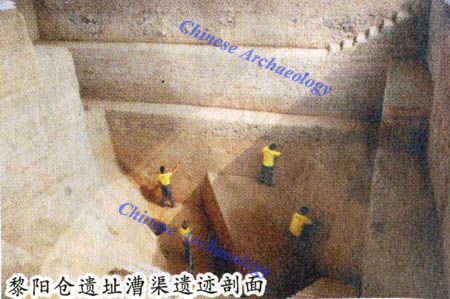
Remains of a north-south canal are found in the north central part of the Liyang granary
Archaeologists of Henan province have surveyed, and excavated the Liyang and Huiluo granary sites of Sui Dynasty comprehensively for the first time under the support and guidance of both the State and Henan Provincial Administration of Cultural Heritage since 2011, as part of the application of China’s’ Grand Canal for the List of World Heritage. Basically, we have gathered information on the water transportation and the overall layout of the two sites such as range, roads, storage pits, management areas…etc. We have found the city wall, moat, rammed-earth foundation, remains of the granary storage pits, roads, canal for transporting grains, and the foundations of large buildings…etc.
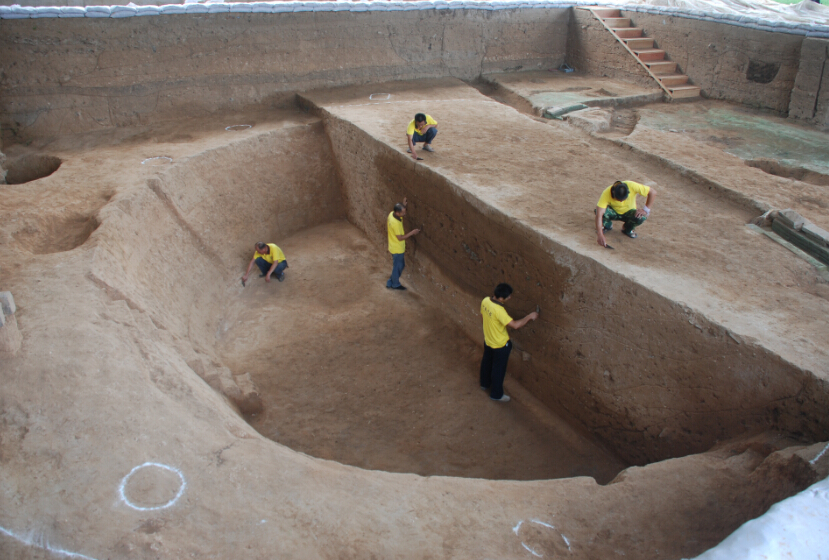
archaeologists are excavating the storage pit C6 of the Liyang granary

wooden plank remains found in the bottom of storage pit C6 of the Liyang granary
The Liyang granary site of Sui Dynasty is located in Dongguan Village, Chengguan Town, Jun County, Henan Province. The site was built near the mountains with a rectangular shape. It has the width of 260 meters from east to west, length from south to north of 300 meters, and the perimeter of 1100 meters. The city wall was built by rammed earth. The excavated east city wall shows a northeast-southwest direction, with a width of 5.5 meters. The moat is 3.5 meters apart from the east side of the east city wall, with a width of 3.9 meters. Two rows of postholes in the same direction of the moat are uncovered in the middle part of the moat. There is another moat located about 10 meters outside the east city wall. Remains of a north-south canal are found in the north central part of the site. Remains of a brick wall have been found in the south part of this canal. A rammed earth platform, 40 meters in length and 25 meters in width, is found in the northwest part of the canal.
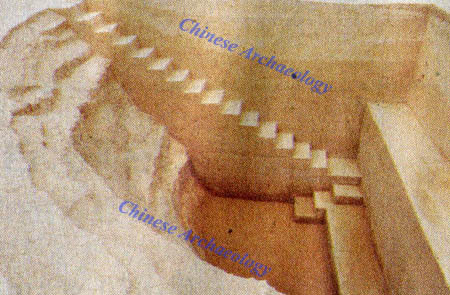
the storage pit C3 of the Huiluo granary
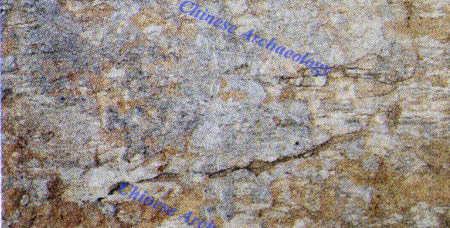
reed mat remains found in the bottom of the storage pit C3 of the Huiluo granary
In accordance with the overall layout of the city, the northwest part could be the places where the water transport and administrative office were. Up to now, 84 crop storage pits had been recognized. All the pits are in a circular shape with large opening and small bottom. The diameter of each pit is various and the largest is around 10 meters. The distance from the bottom of the storage pit to ground surface ranged from 3.8 meters to 7 meters. On the whole, the storage pits are arranged in order. There are about 7 rows of pits from south to north. There are about 10 pits in each row and the space between each row is about 10 meters, except the northeast part. The distance between each storage pit is varied from 3.5 meters to 10 meters. An area of 3000 square meters of the site has been excavated, which includes three storage pits with number C6, C16, and C18. According to the archaeo-botanical analysis, the crop remains found from the bottom of the storage pits are Setaria italica and Panicum miliaceum with glumes. The Liyang granary was abandoned at the beginning of Tang Dynasty.
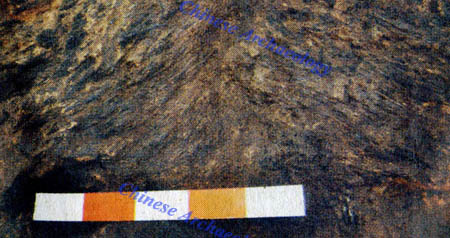
carbonized culm remains found in the bottom of the storage pit C46 of the Huiluo granary
The Huiluo granary site of Sui Dynasty is located to the northeast part of the Luoyang ancient city during Sui and Tang dynasties. The south part of the granary is 1200 meters apart from the north wall of outer wall (guocheng ) of the Luoyang ancient city. Small-scaled archaeological excavation was carried out at the site in 2004 and a brick with the inscription ‘Da Ye Yuan Nian’ (大业元年, the first year of Daye reign, AD 605 ) was uncovered in one of the three excavated storage pits (C56). According to more detailed archaeological survey and excavations since the beginning of 2012, the shape of the site is rectangular, 1140 meters from east to west and 355 meters from south to north. The city wall is 3 meters in width. The site consists of management areas in the centre, storage pits in the east and west side, roads, and canal transport areas. The storage pits are distributed in groups and arranged in order, with 8-10 meters in between. There are 220 storage pits found in the surveyed area of 80,000 square meters. It is suggested that the total number of storage pits in this granary site could be around 700, which is much more than the historical record.
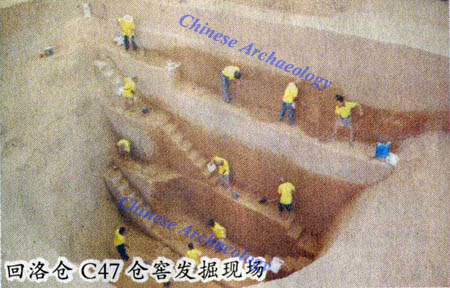
archaeologists are excavating the storage pit C47 of the Huiluo granary
The total excavated area of the Huiluo granary site in 2014 is 4800 square meters, includes 4 storage pits (C3, C46, C47, and C140), 2 main roads, and 4 roads outside the city to the north. All the storage pits have round cylinder shape with large top and small bottom. The diameter of the opening of the storage pit is around 10 meters, and of the bottom is 7 meters, with the depth of 7-9 meters. Both the wall and the bottom of the storage pit were fixed and rammed. The wall was coated with a 20-25 cm thick layer of burnt blue clay paste. The burnt clay paste, wooden plank, and reed mat were placed in order on the bottom of the storage pit. According to the floatation and phytolith analysis of the soil samples from the bottom of the storage pit C143, Panicum miliaceum was the only crop stored in pit C143. The Huiluo granary was abandoned no later than the beginning of Tang Dynasty.
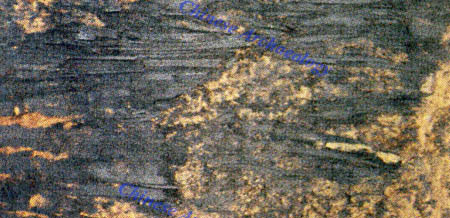
carbonized culm remains found in the bottom of the storage pit C143 of the Huiluo granary
Liyang and Huiluo site are different types of state granary of Sui Dynasty. Rich archaeological data from the excavations of the two sites have revealed the overview of the state granaries, the advanced crop storage technology, and the crop species for storage in ancient China. The excavations of the two sites are significant to the further investigation and reconstruction of Sui Dynasty state granaries. The archaeological data from Huiluo site suggests the scale and structure of the state granary, while the location of Liyang site shows the transportation advantage of the Grand Canal. The archeological discoveries of the two granary sites have provided precious material evidence that relate to the construction of China’s Grand Canal. (Translator: Li Xuelei)

